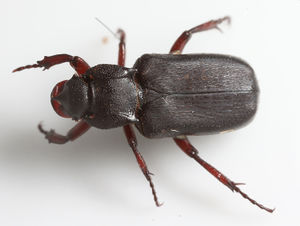Key to Trinodia species
This key to the twelve species of Trinodia is based on: Potts, R.W.L. 1945. A key to the species of Cremastocheilini of North American and Mexico (Coleoptera: Scarabaeidae). Bull. Brooklyn Ent. Soc. 40: 72-78. and Alpert, Gary D. 1994. A Comparative Study of the Symbiotic Relationship Between Beetles of the Genus Cremastocheilus (Coleoptera: Scarabaeidae) and their Host Ants (Hymenoptera:Formicidae). Sociobiology 25(1).
You may also be interested in: Krikken, J. 1982. North American myrmecophilous beetles of the genus Cremastocheilus: discussion of their classification and a review of the subgenera Trinodia and Anatrinodia (Coleoptera: Cetoniidae). Proceedings of the Koninklijke Nederlandse Academie van Wetenschappen. Series C. p. 509-526. and Mynhardt, G. & J.W. Wenzel 2010. Phylogentic analysis of the myrmecophilous Cremastocheilus Knoch (Coleoptera, Scarabaeidae, Cetoniinae), based on external adult morphology. ZooKeys 34: 129-140.
1
- Front of head with a transverse impression in front of eyes; Pronotum only slightly more than one-half as wide as elytra: Arizona (Fig. ) .......Cremastocheilus constricticollis
 Cremastocheilus constricticollis dorsal view |
- Front of head without a transverse impression in front of eyes; Pronotum at least three-fourths as wide as elytra . . . . . 2
2
return to couplet #1
- Tarsi 4-segmented, AZ (Fig. ). . . . . Cremastocheilus lengi
- Tarsi 5-segmented . .... . . . . 3
3
return to couplet #2
- Large tuft of trichome hairs on ocular canthus and in depression centrad and adjacent to anterior pronotal angles. Clypeus strongly carinate at middle (Fig. ) AZ, CA, NV, UT...Cremastocheilus opaculus
- No trichome hairs in a depression centrad and adjacent to anterior pronotal angles ...... . . . . 4
4
return to couplet #3
- Posterior tibia notably broad and laterally compressed.......... . . . . 5
- Posterior tibia not notably broad and laterally compressed...... . . . . 6
5
return to couplet #4
- Body black or piceous; moderate excavation inside and anterior to posterior pronotal angles (Fig. ) ..Cremastocheilus planipes
- Body dark red; posterior angles of pronotum flat above; no excavation inside and anterior to posterior angles ..Cremastocheilus mentalis
6
return to couplet #4
- Femora not broad and compressed; elytra with elongate punctures, longitudinally connected.... . . . . 7
- Femora notably broad and compressed; deep sinuation anterior to acutely pointed posterior angles; elytra with punctures separated .... . . . . 8
7
return to couplet #6
- Body black above; tomentose areas on head, pronotum, elytra, and under surface, large white tomentose areas on each side of median carina...Cremastocheilus stathamae
- Body piceous, slightly shining; no tomentose areas on pronotum, no tomentose areas on each side of median carina..Cremastocheilus spinifer
8
return to couplet #6
- Mentum flat; elytral disc with well-spaced, very slender, narrow, shallow punctures; upper tooth of anterior tibia at about middle of length...Cremastocheilus saucius
- Mentum somewhat cup-shaped; elytral disc with densely spaced punctures, tooth of anterior tibia beyond middle of length .... . . . . 9
9
return to couplet #8
- Body shining; posterior tibia not peductulate; no deep excavation anterior to posterior angles.Cremastocheilus quadricollis and Cremastocheilus setosifrons
- Body opaque to subopaque; anterior and posterior tibia pedunculate; a deep excavation inside and anterior to each posterior angle.... . . . . 10
10
return to couplet #9
- Middle and posterior tibia not noticeably compressed; tarsi not rounded; mentum only slightly cup-shaped ..Cremastocheilus hirsutus
- Middle and posterior tibia compressed; tarsi short, rounded, segments subequal; mentum somewhat cup-shaped..Cremastocheilus excavatus






